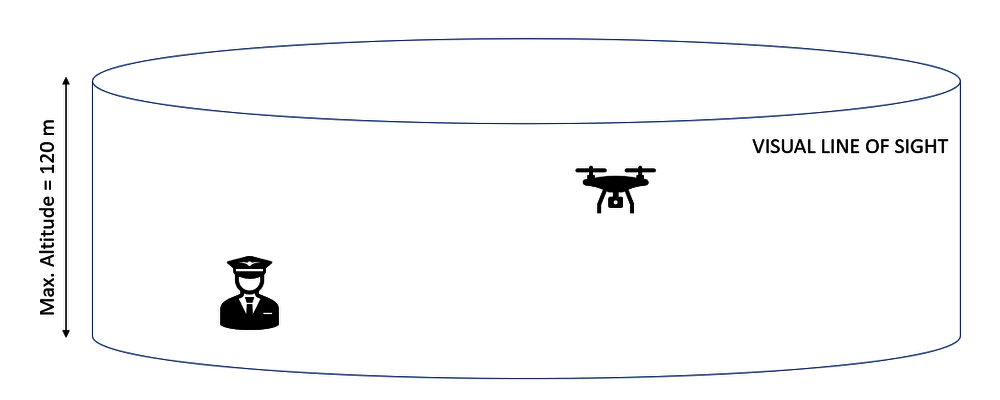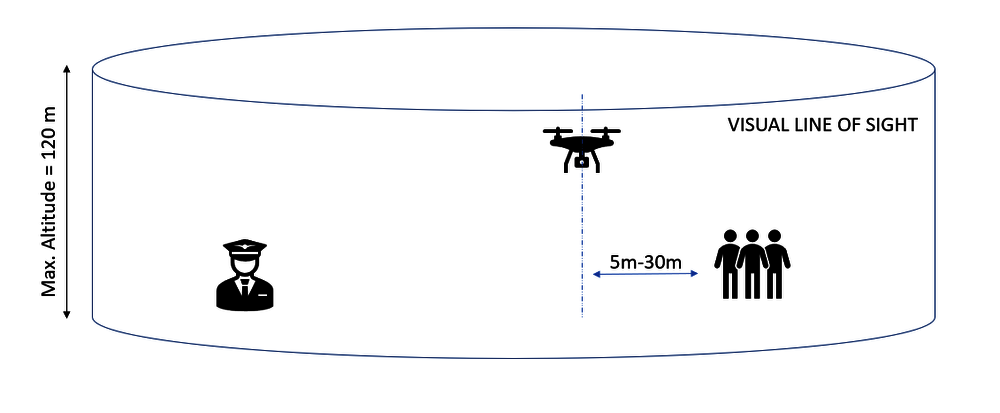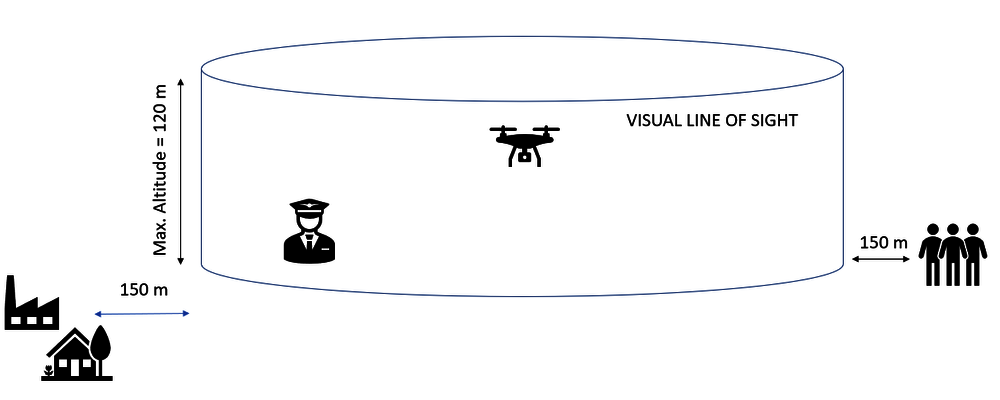Regulations for UAS operations
The Open Category
Author: Rohith Maben - Last update: 2023-08-31
When you fly a drone, you must follow the rules that apply to aviation. The European Commission has drawn up new regulations for drone flights with the help of the European Aviation Safety Agency (EASA). According to the Swedish Transport Agency, you do not need a special permit for piloting drones up to the weight limit of 25 kilograms. [1][2]
The remote pilot responsible for the aerial vehicle is required to have a drone license and an operator ID and follow the three basic rules:
- Pilot the UAS within the visual line of sight.
- Maximum altitude of 120 meters above the ground.
- Not to put the lives of others in danger.
Specific to the area where the flight operations take place, several permissions might be needed to acquire, such as a dissemination permit for images and video, from the Swedish mapping, cadastral and land registration authority (Lantmäteriet), or a permit from the nearest airport to fly within its control zone. [1]
Suppose the flight exceeds any of the limitations for the open category. In that case, you must follow the rules for either the specific or certified category.
Operations in the ‘open’ category shall be limited to flights conducted in visual line of sight (VLOS) and heights not exceeding 120 m above the surface. As described below, the ‘open’ category of UAS operations is divided into three subcategories: A1, A2, and A3.
In addition to these subcategories, class markings are necessary to prove the technical aspects of the UAS. A drone that meets the technical requirements is CE rated, which means that a manufacturer or the importer attests that the product conforms to EU basic health, environmental, and safety requirements. A drone must have a C marking according to its technical specifications. These specifications are defined in the following classes: C0, C1, C2, C3, and C4. [2]
Class marking | Regulations |
C0 |
|
C1 |
|
C2 |
|
C3 |
|
C4 |
|
Subcategory A1

- According to subcategory A1, no flight over groups of people is allowed, and reasonably expect that no uninvolved person is overflown. In case of unexpected overflying over uninvolved persons, the remote pilot shall reduce the time during which the unmanned aircraft overfly those persons as much as possible.
- When the operation involves flying the UA near a fixed obstacle that is taller than 120 m, the maximum height of the UAS operation may be increased up to 50 m above the height of the obstacle, for the portion of the flight close to it and at the request of the entity responsible for the obstacle. [2]
- The flights must be performed by a remote pilot who has been familiarized with the UAS to be operated; or in the case of a UA with an MTOM, including payload, of more than 250 g, demonstrated the competencies necessary to ensure a safe flight, respecting privacy, data protection, security, and environmental requirements, by having completed an online training course and passed an online test, according to a manner and format established by EASA, and provided by an entity recognized by the competent authority.
- The flight operations shall be performed with an Unmanned aircraft when privately built that has an MTOM, including payload, of less than 250 g; marked as class C0, marked as class C1 and operated with active and updated electronic identification and geo-awareness systems. [2]
Subcategory A2

The UA is not flown over uninvolved persons and is operated at a safe distance from uninvolved persons. The UAS must maintain a horizontal distance of at least 30 meters from uninvolved persons or up to 5 meters when the low-speed mode function is activated.
The remote pilot must hold a certificate of remote pilot competency that is necessary to ensure a safe flight, respecting privacy, data protection, security, and environmental requirements, by passing a theoretical test in a manner and format established by EASA at an entity recognized by the competent authority. This authority in Sweden is the Swedish Transport Agency.
With a UA marked as class C2 operated with active and updated electronic identification and geo-awareness systems. [2]
Subcategory A3

In an area where the remote pilot reasonably expects that no uninvolved person will be endangered within the range where the Unmanned Aircraft will be flown during the entire UAS operation. It is also necessary to keep a safe distance from the boundaries of congested areas.
A remote pilot who has demonstrated the competencies necessary to ensure a safe flight, respecting privacy, data protection, security, and environmental requirements by having completed an online training course and passed an online test according to a manner and format established by EASA and provided by an entity recognized by the competent authority; and
The maximum weight, including payload, must be less than 25 kilograms. With a UAS marked as class C2 and operated with active and updated electronic identification and geo-awareness systems, marked as class C3 and operated with active and updated electronic identification and geo-awareness systems; or marked as class C4 [2]
Training for remote Pilots
Open category remote pilots must undergo training and take a test. Having passed the test, the pilot will get a drone license, which allows him or her to fly a drone. The drone license is valid for 5 years.
The pilot must be acquainted with the operation manual from the UAS manufacturer for safe functioning.
The following is an outline of the steps involved in acquiring a pilot license for a UAS:
- Completing the online training
- Conduct a self-practical training in a “safe” area (A3 subcategory conditions)
- Declare completion of the practical training
- Pass a written test from an entity recognized by the competent authority.

Reference:
[1] Drones – unmanned aircraft https://www.transportstyrelsen.se/en/aviation/Aircraft/drones--unmanned-aircraft/
[2] Easy Access Rules for Unmanned Aircraft Systems (Regulations (EU) 2019/947 and 2019/945) https://www.easa.europa.eu/en/document-library/easy-access-rules/easy-access-rules-unmanned-aircraft-systems-regulations-eu

